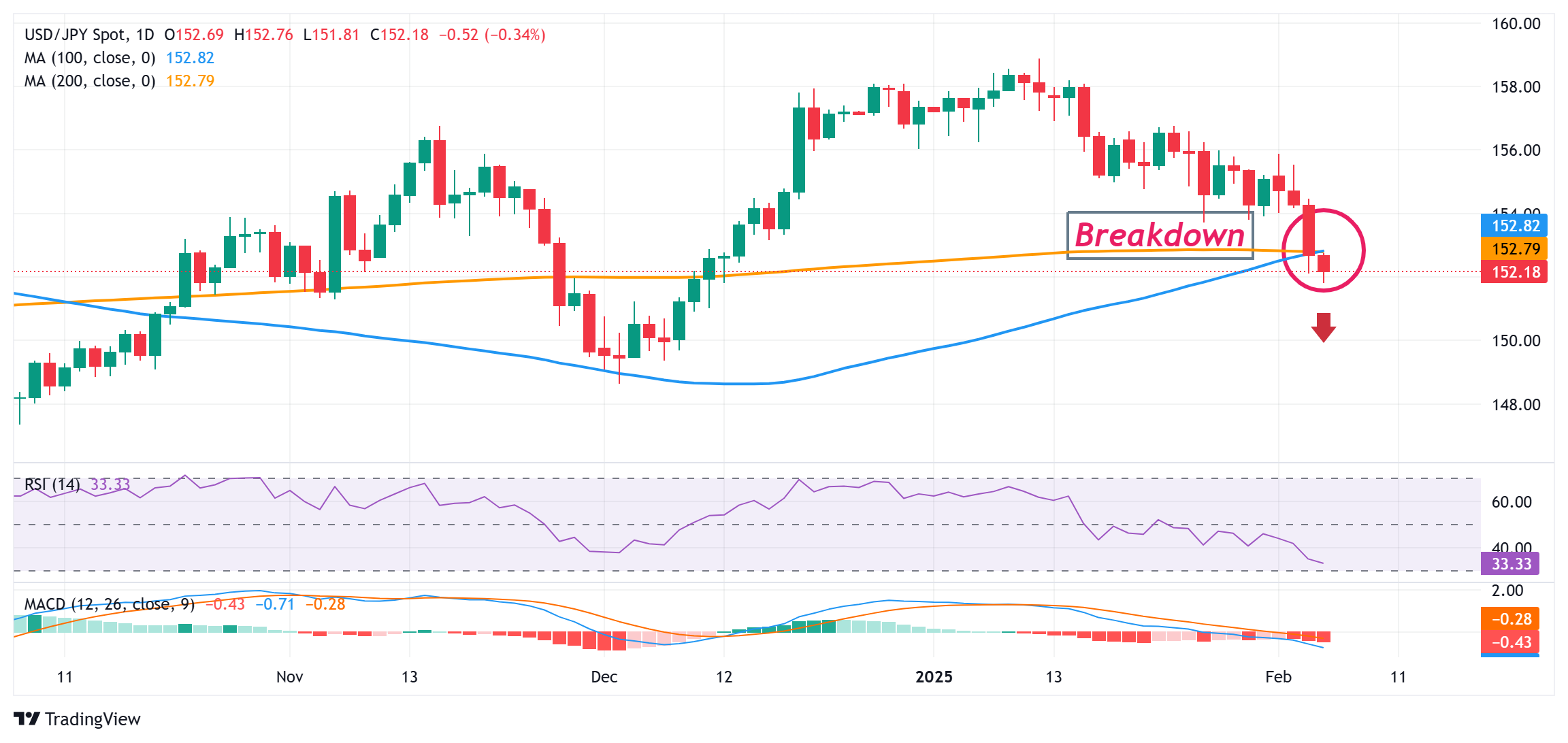- The Japanese Yen retreats from a two-month top touched against the USD this Thursday.
- A positive risk tone caps the safe-haven JPY and offers some support to the USD/JPY pair.
- The divergent BoJ-Fed policy expectations should help limit any meaningful JPY downfall.
The Japanese Yen (JPY) attracts intraday sellers after touching a nearly two-month top against its American counterpart earlier this Thursday and currently trades near the lower end of its daily range. Worries that Japan would also be an eventual target for US President Donald Trump’s trade tariffs and the risk-on mood turn out to be key factors undermining the safe-haven JPY. Apart from this, a modest US Dollar (USD) rebound from over a one-week low assists the USD/JPY pair to climb back above mid-153.00s in the last hour.
Any meaningful JPY depreciation, however, seems elusive in the wake of the growing acceptance that the Bank of Japan (BoJ) would hike interest rates further. Adding to this, bets that the Federal Reserve (Fed) will stick to its easing bias, which would result in the narrowing of the rate differential between Japan and the US, should act as a tailwind for the lower-yielding JPY. This, in turn, favors the JPY bulls and warrants some caution before confirming that the USD/JPY pair has bottomed out and positioning for further intraday gains.
Japanese Yen attracts intraday sellers amid the risk-on mood, reviving USD demand
- Data released on Wednesday showed a rise in Japan’s real wages, which reaffirms bets that the Bank of Japan will raise interest rates again and continues to underpin the Japanese Yen.
- Japan’s Finance Minister, Katsunobu Kato, said on Thursday that he sees inflationary conditions as prices continue to rise further, though the end of deflation has not yet been achieved.
- Separately, BoJ Board Member, Tamura Naoki, backed faster interest rate hikes and said that the central bank must raise rates at least to around 1% in the latter half of fiscal 2025.
- According to LSEG, market participants are currently pricing around a 94.8% chance for a quarter-point hike by the BoJ at its September monetary policy meeting.
- In contrast, the markets are pricing in the possibility that the Federal Reserve will cut interest rates twice by the end of this year amid signs of a slowdown in the US job market.
- The Job Openings and Labor Turnover Survey (JOLTS) showed on Tuesday that the number of job openings fell from 8.09 million in the previous month to 7.6 million in December.
- Moreover, the Institute of Supply Management (ISM) reported that the economic activity in the US service sector continued to expand in January, albeit at a softer pace than in December.
- The US ISM Services PMI declined from 54.0 to 52.8 in January and the Prices Paid Index dropped to 60.4 from 64.4, while the Employment Index edged higher to 52.3 from 51.3.
- The softer services activity data dragged the US Treasury bond yields lower, which undermined the US Dollar and exerted heavy downward pressure on the USD/JPY pair.
- The USD failed to gain respite from the Automatic Data Processing (ADP) report, which showed that the private sector added 183K in January compared to 176K in the previous month.
- Fed Vice Chair Philip Jefferson said on Thursday that he is happy to keep the Fed Funds on hold at the current level and that he will wait to see the net effect of Trump’s policies.
- Thursday’s US economic docket features the release of Challenger Job Cuts and the usual Weekly Initial Jobless Claims data, which might provide some impetus to the Greenback.
- The market focus, however, will remain glued to the closely-watched US monthly employment details – popularly known as Nonfarm Payrolls (NFP) report due on Friday.
USD/JPY might struggle to capitalize on intraday move up beyond the 152.50 confluence
From a technical perspective, the overnight breakdown and close below the 152.50-152.45 confluence – comprising the 100- and the 200-day Simple Moving Averages (SMAs) was seen as a fresh trigger for bearish traders. A subsequent fall below the 152.00 mark validates the negative outlook and suggests that the path of least resistance for the USD/JPY pair remains to the downside. Given that oscillators on the daily chart are still away from being in the oversold zone, spot prices could slide further toward the 151.50 intermediate support en route to the 151.00 mark and the 150.60 horizontal support.
On the flip side, an attempted recovery might now confront stiff resistance and remain capped near the 152.50 confluence support breakpoint. A sustained strength beyond, however, might trigger a short-covering rally and lift the USD/JPY pair beyond the 153.00 mark, toward testing the next relevant hurdle near the 153.70-153.80 region. This is closely followed by the 154.00 round figure, which if cleared might negate the negative outlook and shift the near-term bias in favor of bullish traders.
Risk sentiment FAQs
In the world of financial jargon the two widely used terms “risk-on” and “risk off” refer to the level of risk that investors are willing to stomach during the period referenced. In a “risk-on” market, investors are optimistic about the future and more willing to buy risky assets. In a “risk-off” market investors start to ‘play it safe’ because they are worried about the future, and therefore buy less risky assets that are more certain of bringing a return, even if it is relatively modest.
Typically, during periods of “risk-on”, stock markets will rise, most commodities – except Gold – will also gain in value, since they benefit from a positive growth outlook. The currencies of nations that are heavy commodity exporters strengthen because of increased demand, and Cryptocurrencies rise. In a “risk-off” market, Bonds go up – especially major government Bonds – Gold shines, and safe-haven currencies such as the Japanese Yen, Swiss Franc and US Dollar all benefit.
The Australian Dollar (AUD), the Canadian Dollar (CAD), the New Zealand Dollar (NZD) and minor FX like the Ruble (RUB) and the South African Rand (ZAR), all tend to rise in markets that are “risk-on”. This is because the economies of these currencies are heavily reliant on commodity exports for growth, and commodities tend to rise in price during risk-on periods. This is because investors foresee greater demand for raw materials in the future due to heightened economic activity.
The major currencies that tend to rise during periods of “risk-off” are the US Dollar (USD), the Japanese Yen (JPY) and the Swiss Franc (CHF). The US Dollar, because it is the world’s reserve currency, and because in times of crisis investors buy US government debt, which is seen as safe because the largest economy in the world is unlikely to default. The Yen, from increased demand for Japanese government bonds, because a high proportion are held by domestic investors who are unlikely to dump them – even in a crisis. The Swiss Franc, because strict Swiss banking laws offer investors enhanced capital protection.






